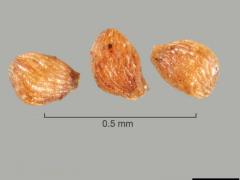Invasive Species: Striga asiatica, Witchweed
Witchweed is listed as a federal noxious weed. It is a parasitic plant that can infest agricultural crops and has been found in North Carolina and South Carolina. Plants are normally 6 to 12 in. (15.2 to 30.5 cm) tall but have grown to 24 in. (61 cm) tall. Leaves are linear and around 1 in. (2.5 cm) long. Flowers are small, less than 0.5 in. (1.3 cm) in diameter; occur in or on loose spikes; and can vary greatly in color from white to yellow, red, or purple. The flowers give way to swollen seed pods that contain thousands of microscopic seeds per pod. Witchweed can parasitize important agricultural crops, such as corn, sorghum, sugarcane, and rice. The host plant’s nutrients are depleted, and energy is spent supporting the parasitic witchweed. Infestations reduce yields and contaminate crops. Witchweed is native to Asia and Africa and was first identified in the United States, in the Carolinas, in 1955.
What are invasive species, and why should we be concerned about them?
Taxonomy: Scientific and Common Names for This Species
Scrophulariales > Scrophulariaceae > Striga asiatica (L.) Kuntze
Synonym(s): Asiatic witchweed
Striga asiatica – USDA PLANTS Profile
Distribution Maps
witchweed – The reported distribution of this invasive species across the United States (Source: Invasive Plant Atlas of the United States)
Up-to-the-minute distribution maps and why they are important
Reporting This Invasive Species
What is the best way to report the occurrence of an invasive species?
How to report an invasive species sighting to EDDMapS – Early Detection & Distribution Mapping System
EDDMapS – Report an invasive species to EDDMapS.
County Extension Offices – Find your county Extension office on this map provided by USDA.
How to Identify
This invasive species can be identified by looking for the characteristics described in the paragraphs that follow.
Plant
Plants are normally 6 to 12 in. (15.2-30.5 cm) tall but have grown to 24 in. (61 cm) tall.
 |
 |
| Florida Division of Plant Industry Archive, Florida Department of Agriculture & Consumer Services, bugwood.org | Florida Division of Plant Industry Archive, Florida Department of Agriculture & Consumer Services, bugwood.org |
Foliage
Leaves are linear and around 1 in. (2.5 cm) long.
 |
|
| Florida Division of Plant Industry Archive, Florida Department of Agriculture & Consumer Services, bugwood.org | bugwood.org |
Flower
Flowers are small, less than 0.5 in. (1.3 cm) in diameter; occur in or on loose spikes; and can vary greatly in color from white to yellow, red, or purple.
 |
|
| Florida Division of Plant Industry Archive, Florida Department of Agriculture & Consumer Services, bugwood.org | bugwood.org |
Fruit
The swollen seed pods contain thousands of microscopic seeds per pod.
 |
|
| Julia Scher, USDA APHIS PPQ, bugwood.org | bugwood.org |
Native Species That Resemble Witchweed
– Images at invasive.org
| bugwood.org | bugwood.org |
– Images at invasive.org
| bugwood.org | bugwood.org |
Additional Images for Witchweed
witchweed – Images at Invasive.org
Learning Resources for Witchweed
Additional Information, Biology, Control and Management Resources
Control and management recommendations vary according to individual circumstances. Location, habitat, weather, and a variety of other conditions are factors that help determine the best treatment choice. To find the safest and most effective treatment for your situation, consult your state’s land-grant institution. If you will use chemicals as part of the control process, always refer to the product label.
United States Land-Grant University System – Find your Land-Grant University’s College of Agriculture, University Cooperative Extension Service, or other related partner on this map provided by USDA.
National Invasive Species Information Center – USDA
Fact Sheet – USDA APHIS PPQ
Federal Noxious Weed Disseminules of the U.S. – USDA-APHIS
Pacific Island Ecosystems at Risk (PIER) – USDA Forest Service
Invasive Species Compendium (Beta) – cabi.org
Invasive Species Information – Global Invasive Species Programme (GISP)
Global Invasive Species Database – Invasive Species Specialist Group (ISSG)
